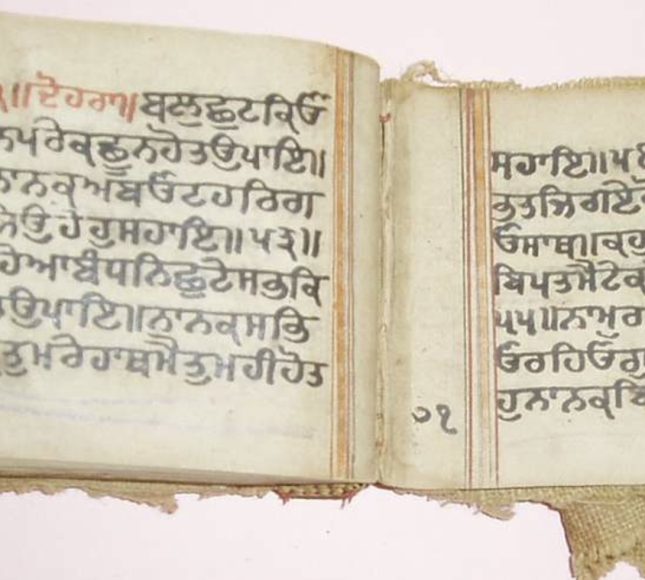Sri Guru Dasam Panchasika, by Sahib Singh Mrigina (c. 1804–1876), is a long panegyric in Braj verse in honour of the Gurus. Sahib Singh, who is the author of some twenty books, was the court poet in the princely state of Jind and was held in esteem for his poetic and scholarly accomplishment by the rulers of Patiala and Nabha states as well. Sri Guru Dasam Panchasika, completed around 1919 Bk/AD 1862, has not yet been published. Its only known manuscript is preserved in the Motibagh Palace, Patiala, under MS. No. 148. It comprises 29 folios, each folio having 7+7 lines. The work concludes with the poet’s prayer to Guru Gobind Singh, the tenth Guru or prophet mentor of the Sikhs, to free him from the cycle of transmigration.
Overview and Context
Guru Dasam Panchasika is a long panegyric composed in Braj verse by Sahib Singh Mrigind (c. 1804–1876). Written in honor of the Sikh Gurus and concluding with a heartfelt prayer to Guru Gobind Singh—the tenth Guru—this work exemplifies the devotional fervor and poetic sophistication of its age. Completed around 1919 Bk (AD 1862), the panegyric remains unpublished, with its only known manuscript preserved in the Motibagh Palace, Patiala (MS. No. 148). The manuscript comprises 29 folios, each featuring a distinctive structure of 7+7 lines, a format that reflects both tradition and formal elegance.
Literary Style and Structure
- Braj Verse and Poetic Flourish:
The use of Braj verse infuses the work with an emotional depth and lyrical quality that was highly esteemed in classical North Indian literature. The rhythmic structure and vivid imagery not only enhance the devotional aspects of the text but also root it firmly within the broader poetic traditions of the Sikh literary heritage. - Panegyric Form and Devotional Exaltation:
As a panegyric, the work is designed to exalt the virtues and accomplishments of the Sikh Gurus. Each stanza is a carefully crafted tribute, interweaving historical memory, theological reflection, and poetic expression. The concluding prayer—requesting Guru Gobind Singh to liberate the poet from the cycle of transmigration—further underscores the central Sikh theme of spiritual liberation and the quest for eternal truth. Historical and Cultural Significance - A Unique Window into Sikh Devotional Literature:
Despite having remained unpublished, Guru Dasam Panchasika offers valuable insights into the devotional practices and literary innovations of 19th-century Sikhism. Sahib Singh Mrigind was a court poet in the princely state of Jind and was highly regarded by the rulers of Patiala and Nabha. His work not only captures the religious sentiments of his time but also reflects the socio-political milieu in which Sikh identity was being robustly articulated and asserted. - Preservation and the Mystique of the Unpublished:
The unpublished status of Guru Dasam Panchasika lends it an aura of exclusivity and mystery. Its solitary manuscript, preserved under controlled conditions at Motibagh Palace, stands as a silent guardian of a literary treasure. For scholars and devotees alike, this rarity is a compelling call to rediscover and engage with a piece of literary and spiritual heritage that has so far remained largely hidden from mainstream discourse.



